Of all the types of ham, what makes Spanish Ham stand out? Learn more about Spain’s love for ham, particularly the delicious Jamón Serrano (Serrano Ham) and the luxurious Jamón Ibérico.
Spanish Jamón is a treasure shared by Spain to everyone in pursuit of great things in life.
Spaniards have nothing but good things to say about the curing tradition etched deeply in the heart of Spanish cuisine.
What is Spanish Ham
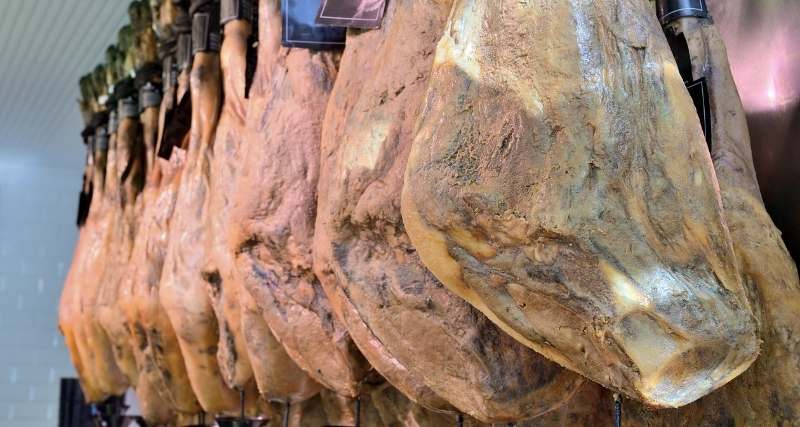
In general, Spanish ham is a pig’s back leg that has undergone dry curing for at least twelve months.
The word Jamon is Spanish for ham. There are two hams in Spain that are both widely consumed yet are worlds apart from each other regarding premium quality: Jamón Serrano and Jamón Ibérico.
Types of Ham
According to the website of the United States Department of Agriculture or USDA, there are three general types of ham:
(1) Fresh ham, which is an uncured pork leg. Fresh hams are beige or pale pink in color.
(2) Cured ham, which is a cured pork leg. Cured hams are deep rose or pink in color.
(3) Cured and smoked ham, a cured pork leg hung in a smokehouse for added flavor and intensified color.
What is Serrano Ham (Jamón Serrano)?
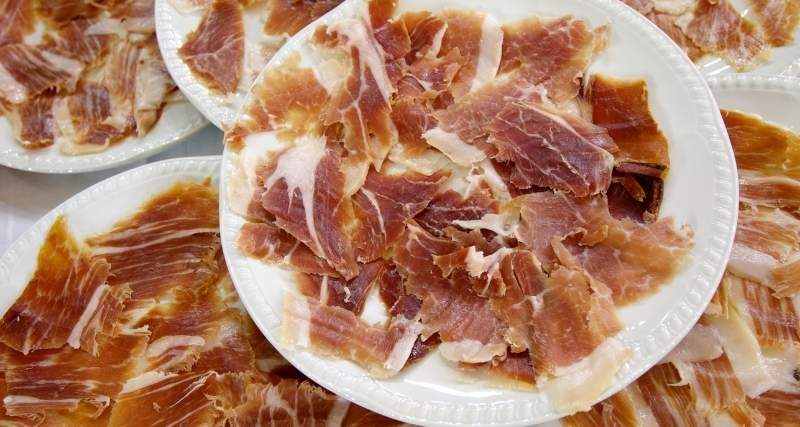
Serrano Ham or Jamón Serrano is the most common Spanish ham. Every household in Spain will surely have one in their fridges, with every person of Spanish descent growing up enjoying this decadent food.
Serrano Ham comes from a cerdo Blanco or a white pig. This type of swine usually lives in enclosed houses, with grains as their primary food.
In Spain, they have an entity called Consorcio del Jamón Serrano Español.
The Consorcio exists to connect fellow Serrano Ham manufacturers. They also function to ensure that the best quality Jamón Serrano gets to the market.
According to the online meat shop Jamon.com, you will know that a Jamón Serrano has passed the high standards of the Consorcio if it bears a branding of “S” in the shape of a ham.
Types of Serrano Ham (Jamón Serrano)
There are two main types of Jamón Serrano:
- Jamón Consorcio-Serrano – are those that have passed the standards of the Consorcio. The Spain-based pig farms that produce these dry cured jamón meet all requirements. The animals themselves must be sourced from Spain. A minimum of twelve months curing time is set for Jamón Consorcio-Serrano.
- Jamón Serrano – are those that are not guaranteed by the Consorcio. The pig farms producing them may not be in Spain, therefore there is no way that the Consorcio can inspect them. Jamón Serrano has less curing time – seven months, at least.
Furthermore, Jamón Serrano differs from the length of time it has been dry-cured:
De Bodega (ten to twelve months);
Reserva (twelve to 15 months);
and Gran Reserva (15 months and beyond.)
What is Iberian Ham (Jamón Ibérico)?
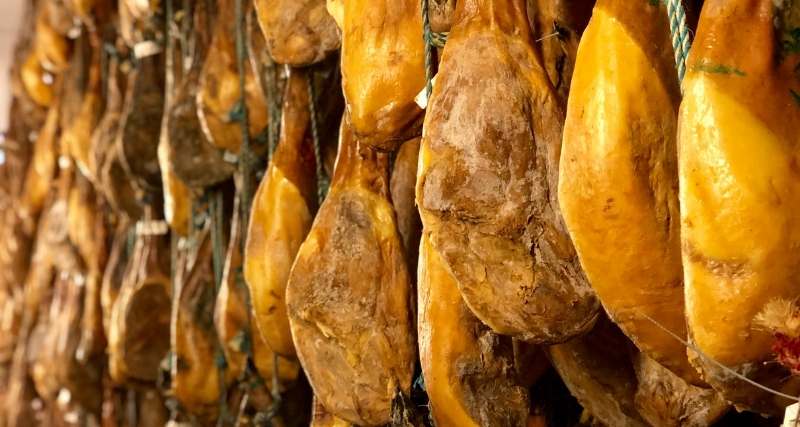
Iberian Ham or Jamón Ibérico is the best Spanish ham. They say that people who have tried this Spanish food have gone to ham heaven.
Iberian Ham comes from a cerdo iberico or an Iberian pig. The animal is also often regarded as Pata Negra. This bit is what makes Iberian Ham so special and luxurious.
Pata Negra is the original breed of pigs that come from Spain. They are black in skin color and also have black hooves, hence the name.
What can make your Iberian Ham cost so much more is the food that the pig eats.
If there is acorn or bellota in its diet, this results in a truly precious taste – good nutty hints and fats that melt as you consume the ham.
For the best Jamón Ibérico, the pigs are set to roam freely around what they call dehesas or oak tree-filled pastures.
This is especially important during the montanera or the last period of their lives – aptly called “acorn season.”
Types of Iberian Ham (Jamón Ibérico)
There are four different types of Jamón Ibérico:
- Jamón 100% Ibérico de Bellota – are Iberian Hams that come from 100% pure-bred Iberian pigs which have been fed pure acorns during the montanera. They come bearing a black label.
- Jamón Ibérico de Bellota – are Iberian Hams that come from Iberian pigs that are not pure-bred but have also been fed pure acorns during the montanera. They come bearing a red label.
- Jamón Ibérico Cebo de Campo – are Iberian Hams that come from pigs that are 50% Iberian. They are fed with grains mixed with a few acorns. They come bearing a green label.
- Jamón Ibérico de Cebo – are Iberian Hams that come from pigs that are 50% Iberian. They are fed with grains and are not free-range. They come bearing a white label.
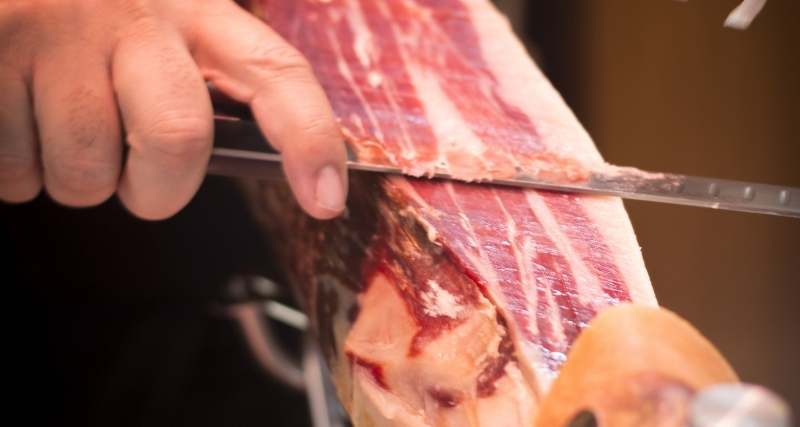
Frequently Asked Questions about Spanish Ham: Jamon Serrano and Jamon Ibérico
What animal does ham come from?
Ham comes from pigs.
What is the difference between Jamon Serrano and Jamon Ibérico?
There are a lot of differences between Jamón Serrano and Jamón Ibérico.
It all starts with the type of pig. Jamón Serrano comes from a cerdo blanco or a white pig. This type of pork is utilized for mass production.
On the other hand, Jamón Ibérico comes from a cerdo Ibérico or an Iberian pig. This type of native pig is treated specially; it even has a specific diet!
When it comes to dry curing, Jamón Serrano is ready for the market after twelve months (or even less.) Jamón Ibérico does not get ready until it’s been two or three years (at least!)
Because of the vast differences between the production of these Spanish hams, supplies vary, too. Jamón Serrano is more common in Spain and international markets, while Jamón Ibérico is a luxurious commodity.
Is prosciutto and Jamon Serrano the same?
Prosciutto and Jamón Serrano are not the same – even if they look so much alike.
What makes the two looking very similar is the fact that both come from white pigs. Therefore, they have the same look when sliced.
However, once you taste each dry-cured meat, you will begin to understand where the similarities end.
Jamón Serrano is saltier and with stronger scent and flavor as compared to Italian prosciutto.
Is Jamon Iberico cooked?
No, Jamón Ibérico is not cooked. It is dry-cured – covered in salt, hung in a drying room, and allowed to mature until it is ready to be enjoyed.

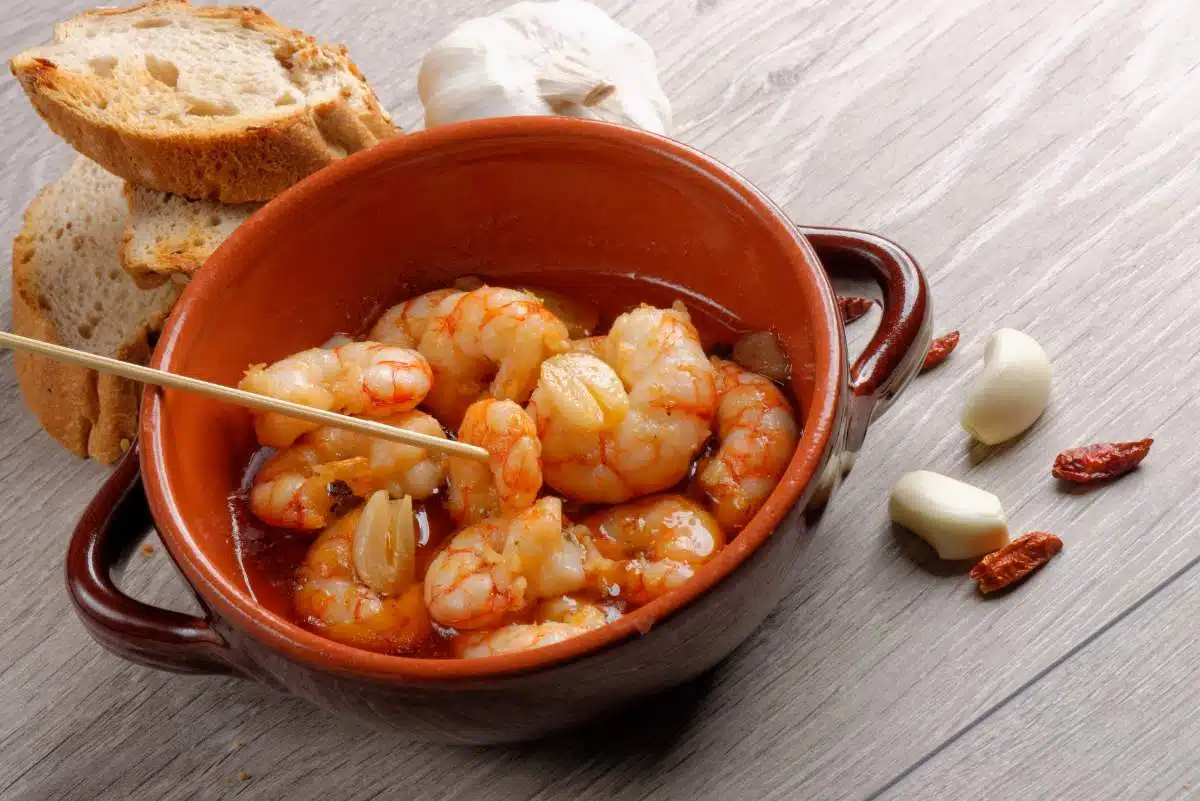


Leave a Reply